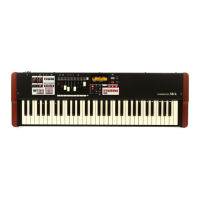*#1
:-%
Owner’s Manual
38
5
1
/3'
16' 8' 4'
2
2
/3'
2'
1
3
/5'1
1
/3'
1'
Middle “C”
e 9 Drawbars on this keyboard are used to create the basic “Hammond” sounds.
Each Drawbar is marked with the register numbers 1 - 8 along the fl at part of the
Drawbar. When the Drawbars are fully pushed in, no sound is heard; as the Drawbars
are “pulled” the volume of that harmonic increases.
When recalling a patch, the drawbars’ “positions” will change internally, but not
physically. When a drawbar is moved, the setting will “snap” to that drawbar’s current
position.
e pitch of each Drawbar is as shown above, when the middle C is depressed. e
footage marked (´) legend in front of each Drawbar is derived from the correspond-
ing length of pipes of a pipe organ.
e numbers 1 - 8 on the “bar” portion of each Drawbar indicate the volume of the
sound to be produced as well as the guide to remember Drawbar settings.
Pull the fundamental (8´), the third harmonic (2⅔ ´) plus the fi fth harmonic (1⁄´)
Drawbars out completely and play the keyboard. Notice how the sound resembles
a clarinet.
If you push the 8´ Drawbar half-way, you’ll notice the sound becomes more high-
pitched and a bit “harder”. Now pull the 8´ Drawbar back out fully and push the
2⅔ ´ and 1⁄´ in halfway. Notice how the sound becomes mellower.
Experiment with the Drawbars to obtain your own personal favorite sounds.
HARMONIC DRAWBARS™
DRAWBARS (ON TONE-WHEEL ORGAN)
In the case of the Tone-Wheel Organ, refer the correspondence
between each bar and the footage to the “TW” row in front of
the Drawbars.
DRAWBAR RESISTRATION
The lengths of the pulled out Drawbars.

